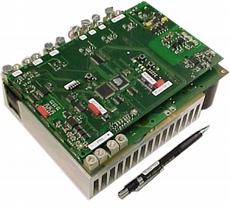How hybrid motors could become cheaper
Not all that long ago, hybrid vehicles were still really exotic. Now, you see them more and more frequently on our roads. However, hybrid cars are not mass-produced as their production costs are still relatively high. A researcher from ETH Zurich has now developed a new concept as part of her doctoral thesis that integrates power electronic functions and an electric motor, which could reduce the costs of producing hybrid cars.

Ever since Hollywood stars like Leonardo DiCaprio and Cameron Diaz proudly began to drive up to the red carpet in their hybrid cars, they have become increasingly interesting for the conventional car market. As the public climate debate continues, hybrid cars with a combination of a combustion engine and an electric motor have increasingly become the focus of research projects.
Hanna Plesko, a doctoral student at Power Electronic Systems Laboratory, may well come to ETH Zurich on public transport every morning, but she devotes the rest of her day to drive systems for cars – or more precisely, power electronic converters for hybrid cars, as they are the subject of her doctorate, which she is due to finish in December. “And I don’t even own a car!” she laughs.
Hybrid drives still costly
The production of hybrid drives is still very expensive at the moment. “It’s rumored that hybrid vehicles can improve your image, but in some cases the automobile companies have difficulties to cover their costs”, says Plesko. This begs the question as to how hybrid vehicles can be constructed more cost-effectively. A substantial proportion of the costs is swallowed up by the electric motor and the power electronic energy management system, in which inverters and DC/DC converters play a crucial role. However, Plesko’s approach is based on a new concept where these components, i.e. the power electronics and the electric motor perform several functions simultaneously. The multiple use of the electronic parts and the motor also saves volume.
Combination with motor has its advantages
In conventional hybrid vehicles, batteries not only power the electric motor, but also the radio, ventilation and the lights. Unlike the electrical drive system, for which a high DC voltage of 200 – 600 V has to be converted into a three-phase AC voltage, a low DC voltage of 12 V is sufficient to power a car radio. Inverters, which convert the direct current into an alternating current, and DC/DC converters, which transfer the power between the two batteries for the two voltage levels, are therefore important power electronic components in hybrid or electric vehicles. For current hybrid vehicles, these converters are located outside the electric motor. In the research group “Future Automotive Power Electronics” headed by senior scientist Jürgen Biela, Plesko has developed a system for her doctoral thesis that integrates the inverter, the DC/DC converter and the electric motor functionally. By condensing the functions of the drive and the DC/DC converter in combination, certain electronic components and the motor lamination stack can be shared. Large quantities of such functionally integrated systems will be cheaper as fewer raw materials are needed. Moreover, Plesko’s design is less complex, making it easier to produce.
For her prototype, Plesko used a motor with an output power of 3 kW. 50 kW would have been more realistic, but the test set-up was not designed for such high power levels. However, she is convinced that her design will also work for real engine power. Two patents have been applied for.
Automobile industry contacted
There have already been initial talks with one of the big car companies, but whether a collaboration will materialize remains unclear as yet.
According to Johann Kolar, a professor of power electronics and Plesko’s supervisor, the implementation of new concepts in the field of hybrid vehicles is often difficult for car manufacturers. The difficulty lies in marrying their traditionally dominant engineering expertise with new areas like power electronics, storage technologies and electromechanical energy conversion to obtain a forward-looking overall concept with an excellent performance. Japanese automobile manufacturers have assumed a pioneering role in this respect: mechanical and electrical engineers work hand in glove, resulting in a very wide range of expertise with great technological depth. This extends to the production of the automobile companies’ own power semiconductors.
For Kolar, Plesko’s new concept is a useful advancement. Whether it will make it onto the hybrid market, however, remains to be seen. Alternatively, it could have interesting applications for industrial automation, robotics and the field of “more electric aircraft”, where new concepts are being developed e.g. for electric actuation of fight control surfaces and air conditioning as well as for onboard electrical energy management.







READER COMMENTS